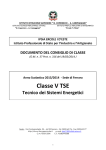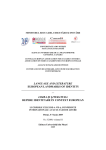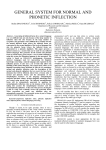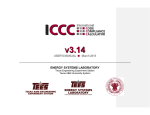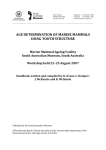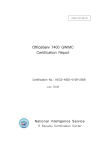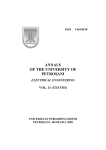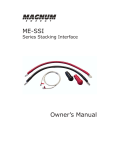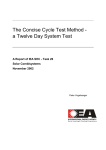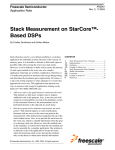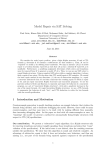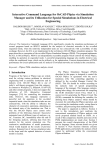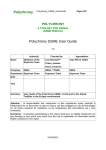Download T - Wseas
Transcript
Virginia Finca, Radu Zglimbea, Emilian Greaban, Constantin Marin WSEAS TRANSACTIONS on SYSTEMS and CONTROL Methods for Parameters Identification of a HVAC Installation VIRGINIA FINCA, RADU ZGLIMBEA, EMILIAN GREABAN, CONSTANTIN MARIN Department of Automation University of Craiova Bd. Decebal, no.5, Craiova ROMANIA [email protected] Abstract: — This paper presents a procedure for time variant system identification based on some experimental studies. Some of the system parameters change in time according to unknown laws. These laws are expressed as finite degree time polynomials whose parameters are included in the set of parameters to be identified. Mainly it is an extension of the procedure developed in [1]. The theoretical methods are now applied on some concrete platform. Our paper presents the concretization of some experimental identification methods on experimental workbench from Quanser. HVAC installation is a test installation for controlling temperature in a chamber, and for parameters identification Key-Words: - Continuous time systems, Identification, Nonlinear systems, HVAC, Quanser. direction in continuous-time system identification is to transform the system differential equations to an algebraic system that reveals the unknown parameters. By using some measures, the direct computation of the input-output data derivatives can be completely avoided. For linear system identification, several methods are reported on this direction: identification based on weighted moments; use of the Poisson moment functional; using the Laplace transformation and then use the Laguerre filter; or transforming the continuous-time system to the frequency domain. [4],[11],[12],[16] Nonlinear identification is an increasingly active research area. Among the various approaches that have been developed are nonparametric methods, which are primarily frequency-domain based. These methods include techniques for identifying Volterra kernels, which characterize input-output response fey means of a sum of multi-frequency convolutions. For time-domain simulation, however, it is convenient to construct nonlinear state-space realizations of these maps, which may be difficult in practice [1]. On the other hand, parametric methods have been developed based on structured and 1 Introduction The analysis of time-varying or time-periodic nonlinear systems is challenging, requiring a degree of sophistication not needed for autonomous nonlinear systems. Most analysis methods for timevarying nonlinear dynamical systems are coordinatebased approaches that do not utilize the power and generality afforded to a description using the language of differential geometry. Such an oversight has important consequences in the area of control of under actuated nonlinear systems due to the increasing prevalence of geometric techniques for the study of nonlinear control systems. In recent years, a progress has been made in the area of continuous-time system identification. Even if the most physical systems are naturally continuous, a much more attention has been paid to parameter estimation of discrete-time systems, mainly because they are better suited for numerical implementations. Continuous-time identification makes possible a more direct link to the physical properties and operation of the underlying systems and the direct estimation of physical parameters which have a clear significance. One important ISSN: 1991-8763 455 Issue 9, Volume 4, September 2009 Virginia Finca, Radu Zglimbea, Emilian Greaban, Constantin Marin WSEAS TRANSACTIONS on SYSTEMS and CONTROL unstructured time-domain models. Unstructured or black-box models [1,3] often rely on neural network models to exploit their function approximation properties. Structured or gray-box models [5] are based on the interconnection of linear and nonlinear subsystems [2]. It is essential to ‘know and understand’ a system before it is handled, manipulated or controlled. A system is known through modeling and identification and understood by analysis. Modeling and identification happen to be a conjugate pair of activities in the process of developing knowledge about a system. They are prerequisites to the practice of automatic control. Modeling by itself is a very vast area rich in a host of well-established methods that are based on a variety of principles. Among the many variants, modeling on the basis of physical unified framework principles can hardly be overemphasized, particularly for physical systems. The key problem in system identification is to find a suitable model structure within which a good model is to be found. Fitting a model within a given structure (parameter estimation) is in most cases a lesser problem. A basic rule in estimation is not to estimate what you already know. In other words, one should utilize prior knowledge and physical insight about the system when selecting the model structure. It is customary to distinguish between three levels of prior knowledge, which have been ‘color-coded’ as follows. • White-box models. This is the case when a model is perfectly known; it has been possible to construct it entirely from prior knowledge and physical insight. • Gray-box models. This is the case when some physical insight is available, but several parameters remain to be determined from observed data. It is useful to consider two sub cases. 1. Physical modeling. A model structure can be built on physical grounds, which has a certain number of parameters to be estimated from data. This could, for example, be a state-space model of given order and structure. 2. Semi physical modeling. Physical insight is used to suggest certain nonlinear combinations of ISSN: 1991-8763 measured data signal. These new signals are then subjected to model structures of black-box character. • Black-box models. No physical insight is available or used, but the chosen model structure belongs to families that are known to have good flexibility and have been ‘successful in the past’.[3] Obviously, a large number of dynamical systems encountered in practice are both continuous in time and nonlinear. Moreover, identification of continuous-time systems from available sampled input-output data records is desirable to enhance the interpretation of the dynamical system behavior and to support the controller design. Clearly, the identification of continuous-time nonlinear systems is a topic which has received considerable attention. To identify a plant based on parametric models one requires either a general or a special nonlinear model. The former uses a general description to represent the process while the latter considers nonlinear models of a particular type which are appropriate for certain classes of processes. Thus, nonlinear systems may be investigated with the help of a series polynomial expansions approach, such as a Hammerstein model. The Hammerstein model is a nonlinear model which describes a special class of system nonlinearities, and it can be represented by the series interconnection of a static nonlinear element followed by a linear dynamic model. 2 Theoretical Aspects Of Continuous Time Systems Identification Let us consider a dynamical continuous time system with nu inputs, u : E → E n , t → u (t ), u ∈ Ω u (1) and n y outputs, y:E → E n yu , t → u (t ), u ∈ Γ (2) where Ω represents the set of admissible inputs and Γ is the set of possible outputs. It can be expressed by a differential operator, qθ / (u , y ) = Q(u , y , θ ) (3) whose expression depends on a vector of parameters θ = [θ 1 ...θ i ...θ p ] T 456 (4) Issue 9, Volume 4, September 2009 Virginia Finca, Radu Zglimbea, Emilian Greaban, Constantin Marin WSEAS TRANSACTIONS on SYSTEMS and CONTROL [ ]( The operator (3), whose class can be determined, represents a family of models with a given structure wi (t ) = ∑ Ψi j (u (t ), y (t )) realization of the model if the function ν (t ) = ∑ [Ψ0j (u (t ), y (t ))] pi (5) is the zero function, qθ / (u , y ) = 0 (6) * * * * that means, qθ / (u * * , y* ( ) * * * ) (t ) = Q u (t ), y (t ), θ = 0, ∀t ∈ E (t ) = Q(u (t ), y(t ),θ * ) = 0, ∀t ∈ i, ∀(u, y )∈ Ω × Γ output pair (uT , yT ) , (9) θˆ = θˆ(uT , yT , Q ) (17) (10) in a such a way that, qθˆ / (u , y ) (t ) = 0, ∀t ∈ E (18) T qθˆ / (u , y ) (t ) = 0, ∀t ∈ E , ∀(u , y ) ∈ Ω × Γ system. As the unknown parameter θ has a finite number p of components, then it will be enough to represent a sum of the choose (utilize) a finite number N of time instants, ti , i = 1 : N based on which to create an algebraic derivatives of some known, possible nonlinear, functions Ψi , Ψ , with respect to the input and j 0 (12) equation. In the specific case of (11), this is a linear system (20) Wθ = v Where W is a N × p matrix of real numbers, (13) W = w(t1 ) ;...; w(ti ) ;...; w(t N ) output variables, pi [ ]( wi = ∑ Ψi j (u , y ) ni j ) , i = 1: p j =1 ν = ∑ [Ψ0j (u , y )] (n ) p0 j 0 [ j =1 Parameters pi , nij , p0 , n0j are given integer (22) ] v = [v(t1 ),..., v(ti ),..., v(t N )] (23) unique solution is obtained, −1 θˆ = (W T W ) W T v = θ * (24) Let us denote r = rank (W ) . If r = p , then a (14) i =1 The equation (24) is of no practical interest because it is not recommended to measure (or to estimate) the derivatives of signals, mainly when ] w T (t ) = w1 (t ), ..., wi (t ), ..., w p (t ) ISSN: 1991-8763 Whose i-th row ( i = 1 : N ) is, w(ti ) = w1 (ti ),..., wk (ti ),..., w p (ti ) T T p [ (21) T The symbol v denotes a N column real vector, value of the function qθ / (u, y ) (t ) is a real vector where ] T [ numbers. The identification problem, into condition (11), has a unique solution. At any time instant t, for a measured input-output pair of functions (u, y ) the qθ / (u , y ) (t ) = ∑ wi (t )θ − ν (t ) = w T (t )θ − ν (t ) (19) For any input-output pair (u , y ) observed to that (11) i =1 j T This condition involves, p Where wi and ν respectively. If no model structure Q , (3), and the observed input- A special case is the model (3) expressing a linear relation in the parameters qθ / (u , y ) = Q(u , y ,θ ) = ∑ wiθ −ν = wT θ − ν (16) confusion would appear, then we may drop the subscript T . An identification problem means to determine the parameter θ = θˆ , given the priori information on the 2. Uniqueness condition qθ / (u , y ) (t ) = 0, ∀t ∈ i, (u , y ) ∈ Ω × Γ ⇒ θ = θ * j 0 (uT , yT ) T is denoted by (7) or, equivalently, / (u , y ) (15) Practically, it is possible to record the functions (u, y) in the time interval T ⊂ E only, called observation time interval or just time window. The restriction of the functions (u, y ) to the time interval * * (n ) p0 The value θ = θ * is consistent with the model (5) if and only if the two following conditions are accomplished: 1. Covering condition (8) qθ / (u , y ) = Q (u , y ,θ * ) = 0, ∀(u , y ) ∈ Ω × Γ qθ , i = 1: p j =1 qθ / (u , y ) = Q (u * , y * ,θ * ) * ) j =1 in constant parameters. A triple (u * , y * , θ * ) is a * nij 457 Issue 9, Volume 4, September 2009 Virginia Finca, Radu Zglimbea, Emilian Greaban, Constantin Marin WSEAS TRANSACTIONS on SYSTEMS and CONTROL they are noise contamined. However, the equation (24) has a form as in any discrete time identification problem, where coefficients are values of the functions u and y in different sampling time moments.[9] prevents the evaporation of sweat. High humidity also decreases physical strength, which usually leads to fatigue. An unhealthy surrounding can also affect people’s thinking abilities. Hypothermia, heat stroke, and hyperpyrexia, among others, are some of the illnesses that may also occur Heating, ventilating and air conditioning is based on the principles of thermodynamics, fluid mechanics, and heat transfer, and on inventions and discoveries made by Michael Faraday, Willis Carrier, Reuben Trane, James Joule, William Rankine, Sadi Carnot, and many others. The invention of the components of HVAC systems went hand-in-hand with the industrial revolution, and new methods of modernization, higher efficiency, and system control are constantly introduced by companies and inventors all over the world. 3 Technical Aspects on Taking Experiments In our laboratory we had elaborated some technical procedures for parameters identification. Our installation gave us the perfect way to analyze the results we obtained. HVAC (pronounced either "H-V-A-C" or "Hvak") is an initials or acronym that stands for "heating, ventilating, and air conditioning". HVAC is sometimes referred to as climate control and is particularly important in the design of medium to large industrial and office buildings such as skyscrapers and in marine environments such as aquariums, where humidity and temperature must all be closely regulated while maintaining safe and healthy conditions within. In certain regions (e.g., UK) the term "Building Services" is also used, but may also include plumbing and electrical systems. Refrigeration is sometimes added to the field's abbreviation as HVAC&R or HVACR, or ventilating is dropped as HACR (such as the designation of HACR-rated circuit breakers). The beginning of HVAC is not clear, though as early as second century, a lot of Roman cities were using a central heating system known as hypocaust. This is further popularized during the Industrial Revolution as big factories used it. Now most modern buildings that you see have integrated HVAC. The HVAC system is also known as climate control. This is because these three functions are essential in maintaining comfort in every dwelling. The primary use of HVAC is to regulate room temperature, humidity, and air flow, ensuring that such elements remain within their acceptable ranges. Effective control of such factors minimizes healthrelated risks. A very humid atmosphere impairs the body’s ability to regulate body temperature as it ISSN: 1991-8763 Three Functions of HVAC Heating is significant in maintaining adequate room temperature especially during colder weather conditions. There are two classifications of heating: local and central. The latter is more commonly used because it is more economical. Furnace or boiler, heat pump, and radiator make up the heating system. Ventilation, on the other hand, is associated with air movement. There are many types of ventilation, but they all function similarly. Ventilation is necessary to allow carbon dioxide to go out and oxygen to get in, making sure that people are inhaling fresh air. Stagnant air causes the spreading of sickness, usually airborne, and allergies. But it is also essential to maintain an efficient ventilation system, especially in the attics. Insufficient ventilation usually promotes the growth of bacteria and fungi such as molds because of high humidity. It will also decrease the effectiveness of rafter and roof sheathing insulation because of water vapor condensation. The air-conditioning system controls the heat as well as ventilation. They often come in different sizes. Most air conditioners have large air ducts, so it is better to check out the building first to see if they can be installed. Or else, you can use the split system or remote coils. It is necessary, though, that air ducts are properly cleaned. Pathogens thrive in 458 Issue 9, Volume 4, September 2009 Virginia Finca, Radu Zglimbea, Emilian Greaban, Constantin Marin WSEAS TRANSACTIONS on SYSTEMS and CONTROL dirty air ducts. Return-air grills are also vulnerable to chemical, microbiological, and radiological elements. Thus, HVAC return-air grill height should be that it is not accessible but visible for any observation. In modern buildings the design, installation, and control systems of these functions are integrated into one or more HVAC systems. For very small buildings, contractors normally "size" and select HVAC systems and equipment. For larger buildings where required by law, "building services" designers and engineers, such as mechanical, architectural, or building services engineers analyze, design, and specify the HVAC systems, and specialty mechanical contractors build and commission them. In all buildings, building permits and codecompliance inspections of the installations are the norm. How has technology changed in the HVAC field? Well, using PLCs (programmable logic controllers) in HVAC is the trend nowadays. But a great deal of development of the HVAC system lies on the everchanging technology and continuous innovation. Companies are adopting wireless technology after they found out that networking HVAC controllers, which often use sensors, can eventually cut installation and labor costs. A lot of engineers are also focused on further improving this technology through the use of mesh wireless setup, which will work for both the wireless sensor and wireless controller networks. The only downside of this could probably be the risk of being exposed to RF (radio frequency) radiation. The installation of an HVAC system is imperative if we want to achieve maximum comfort and be healthy in our homes, office spaces, or other building facilities. But you also need to consider the building size in installing an HVAC system. Optimum efficiency and comfort level are best achieved if the system is appropriate for the size. After all, any ineffective system usually means more incurred costs in the future. You should also see to it that HVAC is carefully integrated to the overall building design so other aspects needed for proper operations, such as cabling, are not sacrificed. ISSN: 1991-8763 A. HVAC plant general presentation The Quanser National Instruments Engineering Trainer (QNET) is a versatile and powerful training tool. Amongst its many capabilities, the QNET series of trainers allows for PC based control using the LABVIEW or Matlab programming language, a National Instruments E-Series or M-Series data acquisition card, and an ELVIS workstation. The QNET allows for a scalable laboratory setup utilizing the ELVIS workstation platform As a quick nomenclature, Table 1, below, provides a list of the principal elements composing the Heating, Ventilation, and Air Conditioning (HVAC) Trainer system. Every element is located and identified, through a unique identification (ID) number, on the HVAC plant represented in Figure 1, below. The Heating, Ventillation, and Air Conditioning Trainer QNET module is designed to operate on the NI-ELVIS platform. The ELVIS unit is connected to an NI E-Series data acquisition card inside the PC. The whole installation is presented in figure 1. Figure 1. QNET HVAC process B. Workbench characteristics The QNET-HVAC Trainer system consists of a Plexiglas duct(chamber), equipped with a heater on one end and a blower on the other. A thermistor is placed in between at the location in the chamber where the temperature is to be controlled. The heater is made of a 12- Volt halogen lamp. The blower is a 24-Volt variable-speed fan. 459 Issue 9, Volume 4, September 2009 Virginia Finca, Radu Zglimbea, Emilian Greaban, Constantin Marin WSEAS TRANSACTIONS on SYSTEMS and CONTROL Table 1, below, provides a list of the principal elements composing the Heating, Ventilation, and Air Conditioning (HVAC) Trainer system. Every element is located as it is shown in figure 2, below Figure 2. HVAC process Figure 3. Process Response to a step voltage TABLE 1. HVAC COMPONENTS Apparently the solution to all the problems witch can appear are simply but if we study more careful we will observe that we have some nonlinearity given by the Temperature Sensor. Thus the block diagram of our process it is shown in Figure 4. No 1 2 3 4 Description Heater/ Halogen Lamp Blower/ Fan Temperature Sensor Chamber/ Duct U [V] TEMPERATURE SENSOR The HVAC plant consists of two inputs, namely the heater and blower voltages, for one output, the chamber temperature. The system thermal resistance and capacitance are not known. Additionally, the heater and blower heat flow rate constants are also unknown. Therefore, system identification is required to model the dynamics of the plant. [7],[8] The thermodynamics theory shows that the behavior of chamber cooling dynamics due to air blowing can be approximated by the following simple-lag Laplace transfer function from blower voltage to chamber temperature difference: ΔT (s ) K (1) Gr (s ) = c = rp _ r Vr (s ) τ r s + 1 Y0 C Figure 4. Cooling Process Block Diagram In our case we the Temperature Sensor it is a thermistor with nonlinear characteristics. A thermistor is a type of resistor whose resistance varies with temperature. The word is a portmanteau of thermal and resistor. Thermistors are widely used as inrush current limiters, temperature sensors, selfresetting overcurrent protectors, and self-regulating heating elements. Thermistors differ from resistance temperature detectors (RTD) in that the material used in a thermistor is generally a ceramic or polymer, while RTDs use pure metals. The temperature response is also different; RTDs are useful over larger temperature ranges, while thermistors typically achieve a higher precision within a limited temperature range [usually -90C to 130C]. Thermistors are special solid temperature sensors that behave like temperature-sensitive electrical resistors. No surprise then that their name is a contraction of "thermal" and "resistor". There are basically two broad types, NTC-Negative where the difference with a constant ambient temperature is defined as: ΔTc = Tc − Ta (2) As defined in equation (1), the HVAC system steady-state gain and time constant during cooling, k rp _ r and τ r , can be determined experimentally by analyzing the system open loop response to a step input. A typical first-order temperature response to a blower voltage step input is illustrated in Figure 3, below. The heater voltage is held constant at zero. ISSN: 1991-8763 COOLING PROCESS 460 Issue 9, Volume 4, September 2009 Virginia Finca, Radu Zglimbea, Emilian Greaban, Constantin Marin WSEAS TRANSACTIONS on SYSTEMS and CONTROL Temperature Coefficient, used mostly in temperature sensing and PTC-Positive Temperature Coefficient, used mostly in electric current control. A thermistor is a thermally sensitive resistor that exhibits a change in electrical resistance with a change in its temperature. The resistance is measured by passing a small, measured direct current through it and measuring the voltage drop produced. When a current flows through a thermistor, it will generate heat which will raise the temperature of the thermistor above that of its environment. If the thermistor is being used to measure the temperature of the environment, this electrical heating may introduce a significant error if a correction is not made. Alternatively, this effect itself can be exploited. It can, for example, make a sensitive airflow device employed in a sailplane rate-of-climb instrument, the electronic variometer, or serve as a timer for a relay as was formerly done in telephone exchanges. T [ C] Time Figure 5. Sensor Characteristic The parameters witch we have to identify from this process are the gain factor k rp _ r and the time constant τ r . Using the soft dedicated made by Quanser we have had determined from diagrams presented in figure below some experimental values: Besides practical experiments we had consider that will be useful to simulate our process and compare the results. Thus we create his version in Matlab Simulink and we obtained some edifying results.Our virtual process has the form presented in figure 6. Figure 6. Experimental Cooling Process The response of simulated process is shown in what will follow in figure 7 and the evolution of the system is quite good. We can say that the system work properly even if due to the computer truncation some approximations are made. The standard reference temperature is the thermistor body temperature at which nominal zeropower resistance is specified, usually 25°C. The zero-power resistance is the dc resistance value of a thermistor measured at a specified temperature with a power dissipation by the thermistor low enough that any further decrease in power will result in not more than 0.1 percent change in resistance From experiments we have established the type on nonlinearity witch seems to describe best our sensor. Thus we made our experiments considering that in our process sensors characteristics it is one of the form presented in figure 5. ISSN: 1991-8763 Figure 7. Time response of real process – Simulink 461 Issue 9, Volume 4, September 2009 Virginia Finca, Radu Zglimbea, Emilian Greaban, Constantin Marin WSEAS TRANSACTIONS on SYSTEMS and CONTROL The installation responses in the terms of dedicated soft were obtained and looks like the ones in figure below. Figure 10. Time Evolution of Cooling Process with Identified Parameters In the next stage, after we have made the identification we firs simulate the process. The values of identified parameters were now The response of HVAC installation after we have had identified the parameters it is presented in what will follow. To ensure that our identification methods are good we have made another experiment. The new system makes o comparison between real values and identified value. The new systems is the one from the figure 11 ⎡ deg C ⎤ K rp _ r = 2.45 ⎢ ⎥, τ r = 29,18 [s ] ⎣ V ⎦ and the systems become same as in figure 8 and his response is presented in figure 9 and figure 10 Figure 8. Experimental and Identified Process Figure 11. Error comparisons Figure 9. Time Evolution of Cooling Process ISSN: 1991-8763 462 Issue 9, Volume 4, September 2009 Virginia Finca, Radu Zglimbea, Emilian Greaban, Constantin Marin WSEAS TRANSACTIONS on SYSTEMS and CONTROL 4 Conclusion Through this research has been proved that it is possible to identify all parameters of continuous time systems even if they are related to measured variables by rational expressions. This is possible if the identification problem is formulated as a set of interconnected identification problems with linear dependences between parameters and measured variables. The obtained results have shown that our methods are good and experimental tries has helped us to refine our algorithms. Figure 12. Temperature variation As it is shown in figure above, we can see that identification error produces temperature variation with maximum 0.50C. The variation we obtained in Simulink it reflects on real HVAC installation to as we can see in figure 14 and figure 15. ACKNOWLEDGEMENTS This work was supported by the National University Research Council - CNCSIS, Romania, under the research projects ID 786, 2007 (PNCDI II) References: [1] C. Marin, System Identification Based on Distribution Theory. Proceedings of the IASTED International Conference Applied Simulation and Modelling (ASM 2002), Crete, June, 2002 [2] C. Marin, System Identification by the method of weighted moments, 12th Int. Conference on Control Systems and Computer Science, CSCS 12, Bucharest [3] Marin C., Marin E. D., A distribution approach International of system identification, Symposium SINTES 10 , Craiova, Romania, May 2000. [4] Harish J. Palanthandalam-Madapusi, Jesse B. Hoag, Dennis S. Bernstein, Basis-Function optimization for Subspace-Based Nonlinear Identification of Systems with Measured-Input Nonlinearities, Proceedings of the 2004 American Control Conference, Boston, Massachusetts, June, 2004 [5] H. Unbehauen, G.P. Rao, A review of identification in continuous-time systems, Annual Reviews in Control, Vol 20, 1998, pp. 145-171 Figure 14. Cooling Process with first set of estimated parameters Figure 15. Cooling Process with first set of estimated parameters ISSN: 1991-8763 463 Issue 9, Volume 4, September 2009 Virginia Finca, Radu Zglimbea, Emilian Greaban, Constantin Marin WSEAS TRANSACTIONS on SYSTEMS and CONTROL [6]N. K.Sinh, G. P. Rao, “Identification of continuous–time systems”, Dordreht: Kluwer Academic Press [7] Quanser NI-ELVIS Trainer, Heating, Ventilation, and Air Conditioning User Manual [8] N. K.Sinh, G. P. Rao, Identification of continuous–time systems. Dordreht: Kluwer Academic Press. [9] C. Marin, "System Identification by the method of weighted moments, 12th Int. Conference on Control Systems and Computer Science, CSCS 12, Bucharest. [10] T. Bastogne, H. Garnier, P. Sibille, "PMFbased subspace method for continuous-time model identification deterministic study," Proc. of 11th IFAC Symp.SYSID'97, Fukuoka, July, 1665-1670. [11] A. E. Pearson, A. E. Lee, "On the identification of polynomial input-output differential systems," IEEE Trans.Aut.Contr.,Vol. AC30, No8, 778782. [12] A. Patra, H. Unbehauen, "Identification of a class of nonlinear continuous time systems using Hartley modulating functions," Int. J. Contr. Vol.62, No.6,1431-1452. [13] A. Ohsumi, K. Kameiama, "Subspace identification for continuous-time systems via distribution-based approach," Automatica, 38, 2002, 63-79. [14] W. Kecs, P. Teodorescu, Introduction to distribution theory with technical applications, Editura Tehnica, Bucharest 1975. [15] V. Barbu, Differential equations. Editura Junimea, Iasi 1985. [16] V. Utkin, Sliding modes in control optimization, Springer, 1992. ISSN: 1991-8763 464 Issue 9, Volume 4, September 2009











